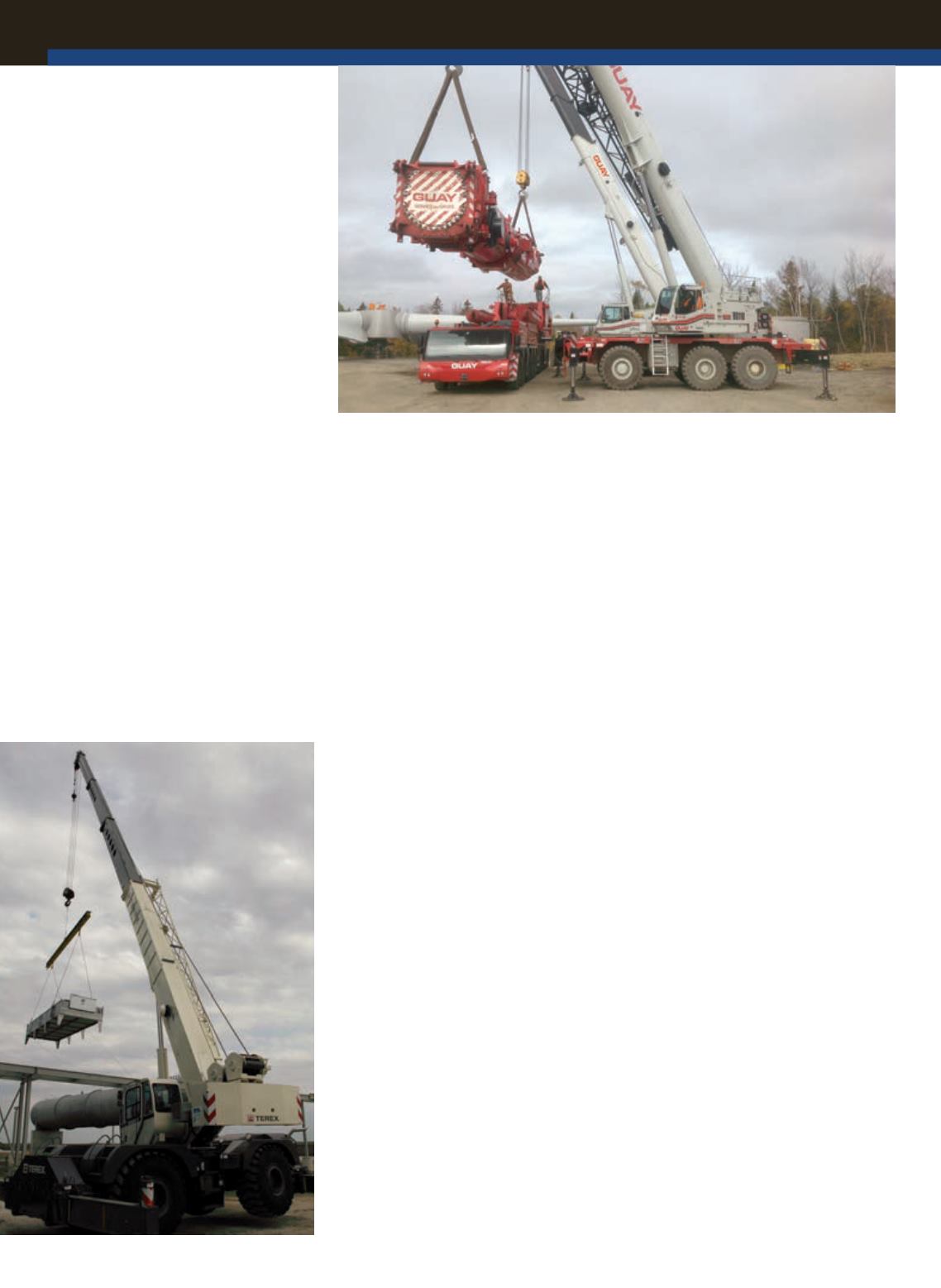
34
ACT
JANUARY 2015
PRODUCT FOCUS
ROUGH TERRAINCRANES
While rental companies are still
experiencing strongdemand forRTs,
TerexandManitowochave reported
slowdowns inRT sales. TadanoAmerica
reports that orders are strong through the
first half of 2015.
“While themarket forRTsmayhave
peaked, Bordelon said “wedonot believe
[this is the case] for the rentalmarket.
Wehave alreadyplacedorders for 2015
delivery, andwe anticipatewewill order
moreRTs.”
The compellingattributesof rough
terrain cranes aremobilityandquick set
up time tomake a lift, Bordelon said.
“We seem tohaveamarket for the30-ton
to100-ton class,”he said. “The75-ton class
hasbeen the leader indemand.”
TimGreenwood, equipment operations
manager for SanAntonio, TX-based
ZachryConstructionCorp., saidbridge
workandundergroundutilityworkkeep
his company’s fleet ofRTsworkingaround
the country.
From bridge to bridge
“We are aheavy civil contractor sowedo
a lot of bridgework,”Greenwood said.
“We like thesemachinesbecause theyare
mobileon the jobsite.Our jobs canbe
pretty choppedup, sowe canget these
cranes around the jobsitequicklywithout
having toput themona truckandhauling
them fromplace toplace.We canusually
drive them fromonebridge to thenext.”
Greenwood estimates thatZachryhas a
fleet of about 20Grove andLink-BeltRTs.
“Weuse the65-ton capacitymachines
mostly, and recentlywepurchased some
80-tonmodels togiveourselvesmore
capacity,”he said.
For the first half of 2015,Greenwood
said theprospects forworkare strong.
“Theydon’t requirenearlyasmuch
preparation for the cranebecause they
can level themselves,”Greenwood said. “It
takes a little lessprepworkas far as setting
up theoutriggers and cranepads.”
From the rough terrain crane sales
perspective,AndyWhitehouse, general
manager, Edmonton,AB-basedProCrane
Sales, saidhis customers inWestern
Canada (both large and small) “use rough
terrain cranes asoneof thekeyassets in
their fleets, and that demand is always
strong.On the largerprojects inWestern
Canada theRT tends tobe the first crane
on the sitewhen construction starts and
the last one to leave sitewhen theprojects
are complete.”
Whitehouse said thatRTdemand in
2015 likelywill decrease compared to
2014,mainlydue to loweroil prices.He
thinks 2015will see steadydemand, but
more like thevolumesof 2010-2012.
“Most of theprojects fueling theRT
rental and salesmarket are largelyoil and
gas related,”he said. “Exampleswouldbe
constructionof pipeline andoil andgas
staging facilities,module fabricationyards
aswell asoil andgasplant construction
andmaintenance.”
He said larger capacityRTs are inmore
demand inwesternCanada. “Allmajor
sites andprojectshavebecomemore safety
consciousover theyears andwith the
components for constructionof these sites
getting larger andheavier, larger capacity
craneswithmoreof a safetymarginare
required,”he said. “Iwould say the two
most common sizes indemandwould
be the75-tonTadanoGR750xl-2and the
100-ton capacityTadanoGR1000xl-2.”
He admits that theRTmarketmayhave
peaked inWesternCanada.
“But continued expansionof theoil
sandsproduction inAlbertaalongwith
the constructionaround the exportation
of theproduct,will continue to fuel the
need formoreRT cranes to support
constructionandmaintenance for years
moving forward,”he said.
Optimistic outlook
LukeLonergan,CEO/vicepresident,
Syracuse,NY-basedEmpireCranes,
agreed that demand forRTshas softened.
“Therewas a lot of supply fromall
manufacturers in themarketplace,”
he said. “We areveryoptimistic and
anticipateutilizationofRTs greater than
in2014.”
Lonergan saidprojects fuelingdemand
forRT rental and sales include large
infrastructureprojects in thenortheast as
well asnew factories and schools.He said
theRT780and thenewQuadstarRT1100
are sought aftermodels.
“For the last 50years the rough terrain
cranehasbeenpresent on the jobsite and
wedon’t see that changing.”
TheRThas the ability towork in less-
than-perfect ground conditions in someof
themost demanding environmentson the
planet and stillworkmaintain reliability
andgood lifting capabilities,Whitehouse
said.
■
In a tandem pick, Guay uses its 110-ton
capacity Link-Belt RT80110 and 100-ton
capacity Link-Belt RT 80100 to place the
boom in into one of its all-terrain cranes.
RTs have the ability
towork in less-
than-perfect ground
conditions in some of
themost demanding
environments on the
planet and still work
maintain reliability
and good lifting
capabilities.


